
 Anmelden
Anmelden
Michael Hieslmair/ Michael Zinganel
Beitrag für die Ausstellung Am Puls der Stadt – 2000 Jahre Karlsplatz, Wien Museum, 2008
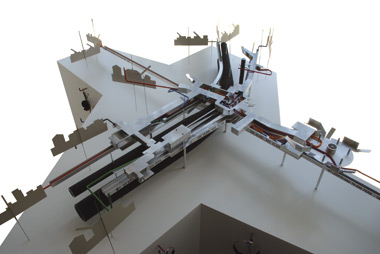
Sozialräumliches Wegenetz-Modell und Audioskulptur, diverse Medien
Die Arbeit entstand auf Einladung des Wien Museums, das direkt am Karlsplatz situiert ist, dessen Geschichte sich die Ausstellung widmete. Die Arbeit wurde im ersten Stock des Museums installiert – zwischen einem historischen Stadtmodell und einem großen Geschoss hohen Fenster von dem aus der Karlsplatz überblickt werden und demnach der Bezug sowohl zur historischen Geschichte des Platzes als auch zu seiner aktuellen Nutzung unmittelbar hergestellt werden kann.
Der Karlsplatz ist einer der bedeutendsten innerstädtischen Verkehrsknotenpunkte der Stadt Wien, der allein auf den drei unterirdischen U-Bahnrouten täglich von 300.000 Passagieren durchquert wird. Der Platz erschließt bedeutende Kultur- und Bildungseinrichtungen (beispielsweise die Oper, das Konzerthaus, die Secession, die Technische Universität und das Wien Museum) und Konsumzonen (den Naschmarkt, die Kärtnerstraße, das Freihausviertel usf.), wird in der medial kommunizierten Wahrnehmung aber vor allem von seinem Image als Treffpunkt von Drogen- und Medikamentenabhängigen dominiert.
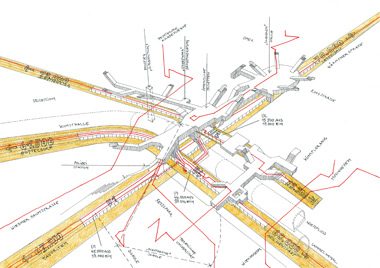
Die Arbeit repräsentiert ein sozialräumliches Modell des Karlsplatzes, in dessen Zentrum das labyrinthartige Netzwerk aus unterirdischen Tunnelröhren, Verbindungsgängen und Passagen steht, das sich um den Kreuzungspunkt der drei U-Bahnlinien spannt. In diesem Modell werden aber nicht nur die Präsenz von Randgruppen, die potentiellen Angsträume und Zonen des Konflikts, sondern vor allem auch die alltäglichen Wege von Akteuren aus unterschiedlichen sozialen Milieus nachgezeichnet, die sich hier kreuzen, einander passieren und die den Platz mit ihren jeweiligen Quell- und Zielregionen verbinden, die mitunter weit außerhalb des Karlsplatzes hinausweisen.
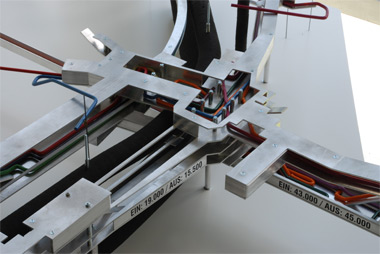
Dazu wurden auf der Mikroebene vor Ort ausgewählte Akteure befragt oder beobachtet und vom Karlsplatz ausgehend auf ihren Wegen bis zu ihren Ein- und Ausstiegsstationen ‚verfolgt’. Ihre zurückgelegten Wege, Raumfolgen und die zeitlichen Rhythmen ihrer Frequentierung werden in ein abstrahiertes dreidimensionales Modell des unterirdischen Tunnelsystems eingebaut. Diese Wege unterscheiden sich durch unterschiedliche Farben und die unterschiedlichen Zeichnungen von Gebäudeschnitten an ihren jeweiligen Enden – an denen die Wege die Wohnhäuser oder Arbeitsorte der Akteure berühren. Den Wegen sind Hörstellen zugewiesen, an denen über Kopfhörer detaillierte Informationen eingeholt werden können, die vom Sprecher der Wiener U-Bahn in einem sachlichen protokollartigem Stil aufgesprochen wurden. Zudem wurden Fahrplänen angefertigt, die dem Layout der Wiener U-Bahn nachgestellt sind, die aber nicht die Wege und Fahr-Zeiten der Verkehrsmittel sondern die der jeweils ausgewählten Akteure beschreiben.
So wird den fest im mentalen Stadtplan verankerten Zuschreibungen, die den Karlsplatz als Angstraum ausweisen, die beispielhafte Darstellung der Raum-Zeitorganisation von Akteuren gegenübergestellt, die gelernt haben, sich aus dem Weg zu gehen oder am Platz zu unterschiedlichen Zeiten permeable Raumzonen für sich und ihre Subkultur zu aktivieren.
Umsetzung
Sozialräumliches Wegenetz-Modell: Gangsystem aus Aluminiumprofilen und -blechen beschriftet mit Verkehrsfrequenz-Daten, Sockel aus lackierten MDF-Platten, schematische Stadt-Schnitt Darstellungen auf Karton, farbige Akteursspuren aus Acrylglas-Stäben, 10 Fahrpläne als Digital-Prints DIN A4, 10 Hörstationen mit mp3-Playern und Kopfhörern, Erzählungen auf gesprochen von Franz Kaida – pensionierter Haltestellenansager der Wiener Verkehrsbetriebe,
Abmessung: 200cm / 270cm /120cm

Tonspuren
zu Stadtraum und Zeit-Wegenetzdarstellungen anhand folgender Akteure
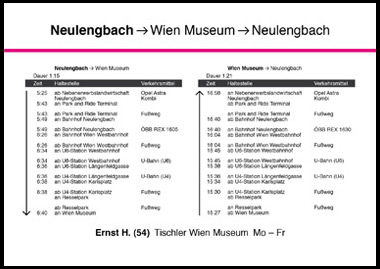
01 Ernst H
Ernst H. (54)
Tischler Wien Museum > Montag – Freitag
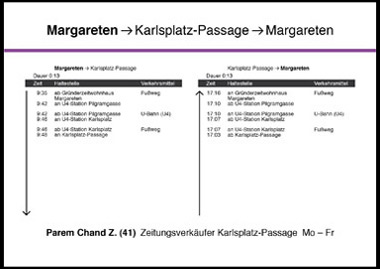
02 Parem Chand Z
Parem Chand Z. (41)
Zeitungsverkäufer Karlsplatzpassage > Montag – Freitag

03 Lisa H+Hermine F
Lisa H. (7)
Schülerin Evangelische Volksschule > Montag – Freitag
und Hermine F. (78)
Großmutter Begleitperson > Montag – Freitag

04 Gabriele+Franz F
Gabriele (73) und Franz F. (78)
Musikvereinsbesucher > ein bis zwei mal pro Monat
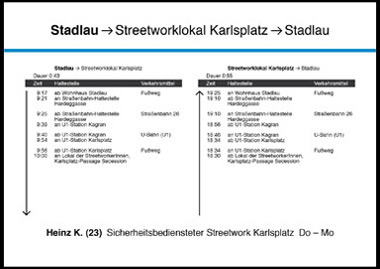
05 Heinz K
Heinz K. (23)
Sicherheitsbediensteter Streetwork – Anlaufstelle Karlsplatz
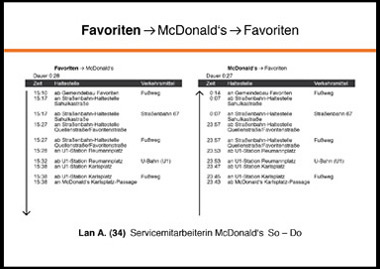
06 Lan A
Lan A. (34)
Servicemitarbeiterin Mc Donalds > Sonntag – Donnerstag
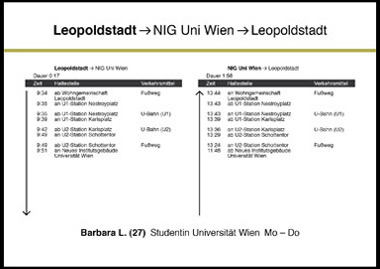
07 Barbara L
Barbara L. (24)
Studentin Universität Wien > Dienstag / Donnerstag
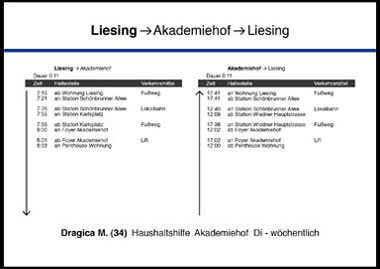
08 Dragica M
Dragica M. (34)
Reingungskraft / Haushaltshilfe Akademiehof > Dienstag
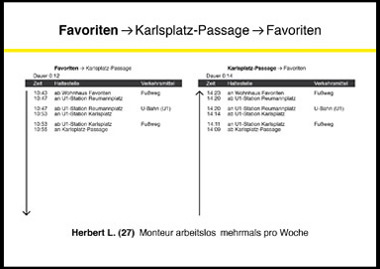
09 Herbert L
Herbert L. (27)
Monteur arbeitslos > unregelmäßig mehrmals pro Woche
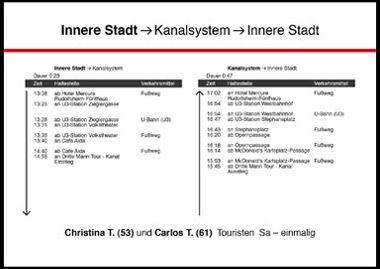
10 Christina+Carlos T
Christina (53) und Carlos T. (61)
Touristen > Samstag
Sprecher: Franz Kaida, pensionierter Haltestellenansager der Wiener Linien
Unterstützung bei der Recherche: Barbara Strametz
Fotos: Michael Hieslmair
Wien Museum
Socio-spatial path network model and audio sculpture, miscellaneous media
A finger on the pulse of the city – 2000 years of Karlsplatz, Wien Museum, 2008
The work was created at the invitation of Wien Museum, situated directly in Karlsplatz, whose history was the focus of the exhibition. The work was installed on the first floor of the museum – between a historical model of the city and a large, storey-high window looking onto Karlsplatz, thus allowing a direct link to both the history of the square and to its current use.
Karlsplatz is one of the most important inner-city traffic junctions in Vienna, with more than 300,000 passengers crossing the square every day on the three underground railway lines alone. The square provides access to major cultural and educational facilities (for example the opera house, Konzerthaus, Secession, the University of Technology, and Wien Museum) and shopping zones (Naschmarkt, Kärtnerstraße, Freihausviertel, etc.), while its perception in the media is dominated above all by its image as a meeting-place for drug addicts.
The work represents a socio-spatial model of Karlsplatz centred on the maze-like network of underground tunnels, corridors and passageways that spans the intersection of the three underground railway lines. However, this model not only indicates the presence of fringe groups, the potential danger spots and zones of conflict, but above all also traces the everyday paths taken by people from different social milieux that intersect at this point and that connect the square with their various origin and destination regions, that in some cases go far beyond Karlsplatz itself.
For this purpose, the project involved interviewing or observing selected actors on the micro-level on site and, starting from Karlsplatz, ‘following’ them on their journeys to the stops where they got on or off. The paths they covered, the sequences of spaces they crossed, and the frequencies are integrated into an abstracted three-dimensional model of the underground tunnel system. These paths are distinguished by means of different colours and the different drawings of building cross-sections at their ends – where the paths lead to the actors’ homes or places of work. The paths are assigned audio points at which people can use headphones to listen to detailed information recorded by Vienna’s underground railway announcer in a matter-of-fact, transcript style. In addition, timetables were drawn up that are based on the layout of Vienna’s underground railway system but which do not describe the routes and travel times of the trains but rather those of the selected actors.
The result is a confrontation of the ascriptions firmly entrenched in the mental map of the city, that identify Karlsplatz as a perceived danger spot, with the exemplary representation of the organisation of time and space of actors who have learned to avoid each other or to activate permeable zones for themselves and their subculture in the square at different times of the day.
Sound-track speaker: Franz Kaida, retired stop announcer for Wiener Linien
Technical description: Socio-spatial path network model: corridor system of aluminium extrusions and sheets labelled with traffic frequency data, base of painted MDF panels, cross-sectional schematics of the city on cardboard, coloured actor paths of acrylic glass rods, 10 timetables as digital prints DIN A4, 10 audio points with MP3 players and headphones, stories recorded by Franz Kaida – retired stop announcer for Wiener Verkehrsbetriebe, Dimensions: 200cm / 270cm /120cm
Sound-tracks, city space and representations of times/paths based on the following actors:
Ernst H. (54) carpenter Wien Museum, Monday – Friday
Parem Chand Z. (41) newspaper seller Karlsplatzpassage, Monday – Friday
Lisa H. (7) protestant primary schoolgirl, Monday – Friday
Hermine F. (78) grandmother accompanying child, Monday – Friday
Gabriele (73) and Franz F. (78) Musikverein visitors, once or twice a month
Heinz K. (23) Streetwork security officer, Karlsplatz section
Lan A. (34) McDonald’s crew member, Sunday – Thursday
Barbara L. (24) student at Vienna University, Tuesday / Thursday
Dragica M. (34) cleaner / home help at Akademiehof, Tuesday
Herbert L. (27) unemployed fitter, several times a week, irregularly
Christina (53) and Carlos T. (61) tourists, Saturday